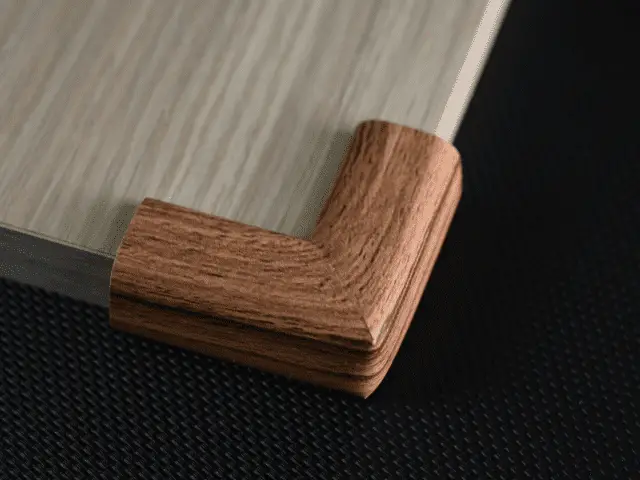Moving can be a hectic experience with lots of accidents waiting to happen. One of the most common moving day accidents is a scuff, or even worse – a hole, ending up on a wall while you’re trying to move furniture.
So, if you’re on the verge of a big move, you might be trying to figure out how to protect your walls when moving furniture. (That’s why you’re here, right?)
Not only because you don’t want to ruin your new place, but because you also don’t want to lose the security deposit on the previous apartment either!
This article may include affiliate links. If you make a purchase through these links I may, at no extra cost to you, earn a commission.
Table of Contents
Protect Your Walls When Moving Furniture
You’re going to quickly notice a common theme when it comes to preventing wall damage and that is having a plan and taking time to prepare.
Many of us (I’ve been guilty as well) just grab things and head to the moving truck. Especially, once fatigue, both mental and physical, starts to set in on a long strenuous day.
The problem is, this is when most ‘accidents’ happen. By taking a minute to prepare a plan, you can better protect walls and your furniture.
So let’s jump right in with some tips and tricks that can help you protect your walls!
Know the Measurements

Anyone that has ever moved or even helped someone else move has heard this line, “You think it’ll fit?”
Don’t just roll the dice and try to wedge a piece of large furniture where it’s just not going to go!
Before you start moving, take the measurements for all doors, hallways, and stairs. Then, compare it to the furniture dimension to make sure that it’ll fit.
Worst case scenario, you’ll know that a specific piece of furniture will never fit. In this case, you’ll have to sell it, donate it or find a different place in your home for it to go.
It might sound obvious enough when you think about it, but somehow, people tend to skip this step entirely!
Take The Time To Disassemble Large Furniture
It can be tempting to move a whole piece of furniture instead of disassembling it since it saves time and effort.
However, it also comes with a bigger risk of ruining the furniture, walls, and door frames. Generally, cutting corners with big jobs like a move is a risk you want to avoid.
Taking the legs off of items like tables and couches can be the difference between these furniture pieces sliding perfectly through door frames and tearing up both the wall, frame and the furniture.
It only takes a couple of minutes to take legs off of most pieces of furniture. On the other hand, repairing a damaged door frame will take much longer (and cost more money).
Just don’t forget to properly store all the bolts, nuts, and screws you need to put the piece back together.
Clear Your Path
Once the moving day comes, you’ll need to make sure that you have a clear path to and from the moving truck.
No boxes, carpets, or bags should be laying around randomly. Instead, you want to assign a designated room to store all the items.
As a plus, remove all portraits and wall decors in advance. Otherwise, they might fall and break during the move.
Get a Moving Dolly
Dollies are such simple gadgets with a profound impact. It’ll protect your back, walls, and carpets all in one swift move!
If you’re not straining while lifting heavy furniture, you’ll get to focus more on the angles and the spaces.
As a plus, a furniture dolly can save your hardwood floors from nasty scuffs and scratches. So, that’s a double win!
Related: We also have plenty of tips for protecting your floors during a move as well!
Use Masonite Wall Covers
When you can’t avoid some friction between the furniture and the walls, go for Masonite covers . You can stick it up with painter’s tape to avoid ruining the paint finish.
. You can stick it up with painter’s tape to avoid ruining the paint finish.
This works great for protecting areas of wall around sharp corners when you’re trying to navigate tight turns, whether into a room or down a tight hallway.
The best part about Masonite is that it’s sturdy enough to be re-used multiple times. So, you can use the same sheets for several rooms, one at a time.
If you can’t get your hand on any Masonite boards, you can always use cardboard. It’s cheaper but provides less coverage.
Hang Comforters Over Your Walls
Another wall protection to consider is a comforter. This method works for smaller future since the fabric isn’t always thick enough to prevent scratches and scuff marks
Unlike masonite, you don’t actually have to buy anything new. You’ll use the comforters that you need to pack anyway.
However, you’ll need a lot of painter’s tape to hold in place. Otherwise, you’ll have to drill into the wall, which is a bit counterintuitive.
Pad the Bulky Items

Sometimes, covering the walls isn’t the smartest move, especially when all your furniture fits easily, with the exception of one or two pieces.
In that case, you can pad these bulky items with bubble wrap or corner guards. Bonus points if you can recycle the bubble wrap for multiple uses during the move!
If you’re not familiar, corner guards are small pieces of plastic or rubber that will slide right onto the corners of tables, desks, etc. They’re cheap and will protect your walls from slight accidental bumps.
Also, similar to the Masonite covers, corner guards can be the perfect solution to help protect walls when trying to maneuver long, bulky items around sharp corners. But, with plastic corner guards, you don’t have to bother with hanging something up on your walls.
If you want heavier coverage, try wrapping the piece with moving blankets or even tie around pillows with rope to puff out some heavy blows.
Get a Helping Hand
Aiming for a DIY moving job doesn’t necessarily mean that you have to do it solo. Get a friend or a family member (or members) to lend you a hand.
It’ll be so much easier to navigate in narrow rooms if you have two people watching either side.
An extra hand will also be particularly useful if you want to hang wall protection, pad furniture, or even load heavy items on a dolly!
Hold the Drawers Firmly Shut
No matter how many precautions you take, if you don’t secure the moving parts of furniture, you can still end up with terrible accidents.
For instance, a loose drawer can hit the wall, fall and leave marks on the floor tiles, or even injure your feet.
To prevent this, try using locks to keep all the drawers shut while you move the item. Rope or tape will get the job done, too.
Hire Professional Movers
If you don’t want to bother with extra precautionary measures, you can always get a professional moving team to handle the entire moving process for you.
They usually have a ton of gadgets and years of experience on the job that guarantees the safety of both your furniture and walls.
However, hiring furniture movers can often be a financial burden that not everyone can handle.
How to Remove Scuff Marks from Walls
Despite your best efforts and precautionary measures, you could still somehow end up with scuff marks.
After all, there are probably multiple people going around the house, and with so much happening at once, mistakes can happen.
If that’s the case, then don’t fret! There are some ways to deal with wall damage like scuffs and scratches. We recommend that you start from the gentlest and make your up if one step doesn’t work:
Wipe With a Dampened Cloth
It sounds so simple, but it could work since sometimes the scuff is only grim from the furniture legs.
Just make sure not to spread the grim and dust all over the wall. Do a tiny test area first and see if it works.
Use Dish Soap and a Sponge
If a dampened cloth doesn’t remove the scuff, you might need to add some sort of detergent to the mix.
Make sure not to overload the sponge with soap. Otherwise, it’ll be hard to wipe the surface clean afterward.
Mix a Baking Soda Paste
Baking soda and vinegar paste is a handy home cleaning product that works on many surfaces, and walls are no exception.
is a handy home cleaning product that works on many surfaces, and walls are no exception.
However, don’t scrub the paste too hard, or else the paint might chip away and damage the finish even more.
Magic Eraser
The dura foam in Mr. Clean’s Magic Erasers can gently scrub away scuff marks without damaging the paint job.
can gently scrub away scuff marks without damaging the paint job.
Some people find that regular pencil erasers can get the job done, as well. So, try both and see which works best.
Grit the Scuff and Top Up With Paint
If you’ve renovated the new place before the move, you might still have some paint left in the can.
In this case, use sandpaper to gently scrub around the scuff, then go over it with a layer of paint to cover the damaged finish.
The Takeaway
Knowing how to protect your walls when moving furniture can be tricky, but definitely not impossible!
You can choose to cover up your walls with comforters, Masonite, or cardboard. On the other hand, you can pad the furniture itself with bubble wrap, corner guards, or blankets.
Plus, using other gadgets like moving dollies can help you manipulate heavy furniture pieces in narrow hallways.
The key here is to plan ahead, take your time, and stay safe (lift with your legs, not your back!)


